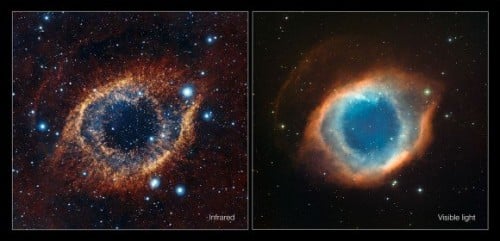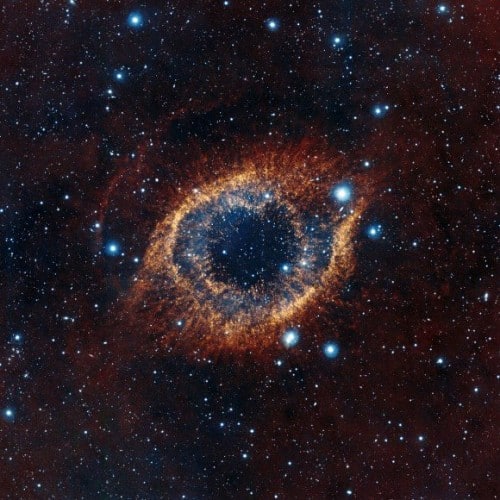The Vista infrared facility at the European Space Agency's telescope in Chile gave a new look at the Helical Nebula - the giant eye in the sky

Who's looking at who here? A new image of the Helix Nebula, also known as the "Eye of God" In the famous viral email Compared to previous images of the Helical Nebula in visible light - in the meantime the eye wore a colored contact lens, changing its color from blue to brown. What the infrared light really reveals are the bands of cold gas within the nebula, which can be clearly seen against the background of distant stars and galaxies.
The Helix Nebula is a planetary nebula located in the constellation Aquarius, about 700 light years from Earth. This strange object orbits a Sun-like star in the last phase of its life. In fact our sun may look like this one day, in a few billion years.
The Helix Nebula is a cave of glowing gases. The main ring of the helix was about two light-years in diameter, about half the distance between the Sun and the nearest star. However, the materials from the nebula were scattered outward to a distance of at least four light years. This is especially clear in the infrared image because the red molecular gas appears to cross most of the image.

In the center of the nebula is a dying star that has blown off huge amounts of dust and gas and created the hunting arm-like filling that stretches towards the outer rim and is composed of the same material. When the star could no longer hold the outer layers it slowly shed them and formed the nebula. The star itself gradually turns into a white dwarf and appears as a tiny blue dot in the center of the image.
The Vista telescope image also reveals the fine structure of the nebula's rings. The infrared light shows how the colder molecular gas is arranged. The material tangles into fibers radiating out from the center and the whole look resembles a cosmic fireworks display or a giant eye.
For the news in Universe Today
More on the subject on the science website

4 תגובות
Thanks to whoever uploaded the link to YouTube!!!
Now it looks even more like Sauron
In my opinion what happened is that God turned around and now we are looking at his rectum. Therefore we must call the nebula from today "the rectum of God".
If you feel like illuminating something a little bigger than a flood of mail, take a look at this
http://www.youtube.com/watch?v=LG0bNpI7H14&feature=player_embedded